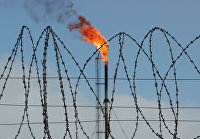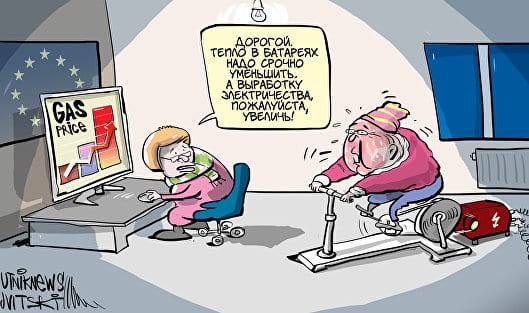MOSCOW, 24 Sep — PRIME, Andrey Karabyants. The energy crisis is hitting Europe tangibly: Germany is spending huge sums to bail out energy companies, losing industry and having to sponsor a huge portion of users who no longer have money to pay their bills. The costs of the EU and the UK to combat the energy crisis amount to hundreds of billions of euros. But it’s not easy for Gazprom either: its exports will drop significantly this year. The parties are about to face a choice: either completely and completely break off the “gas friendship” with far-reaching consequences for everyone, or put up with it.
Hungry and frozen Europeans will force the lifting of anti-Russian sanctions
DO NOT SAVE MONEY
In order to estimate the amount of “gunpowder in the flasks”, one must be aware of the situation in which European consumers of Russian cheap gas find themselves, primarily Germany. According to experts, after the decision to nationalize Uniper, the largest importer of Russian gas, the amount spent on saving this energy company from bankruptcy alone reached 29 billion euros.
Berlin spent more than 40 billion euros on financial assistance from Uniper, VNG, Sefe (formerly Gazprom Germania) – the three largest companies providing energy and gas supply to the country of Germany. Uniper will be nationalized. The nationalization of Sefe, the operator of underground gas storage facilities in Germany, is being discussed.
“The state is doing everything possible to ensure that the position of companies in the market remains stable,” said German Economy Minister Robert Habeck.
The nationalization of energy companies is a recognized necessity, which will prevent interruptions in the supply of electricity and gas to the population, as well as to the most important industrial enterprises. However, price increases cannot be avoided. Khabek said that an additional tax will be introduced for gas consumers in October. This will reduce the losses of energy companies, which, after the cessation of Russian gas supplies, are forced to buy expensive fuel on the spot market, primarily American LNG.
At the same time, European governments spend huge amounts of money on financial assistance to energy companies and subsidies for consumers of electricity and gas. In general, according to the Brueghel Institute in Brussels, the EU countries have spent almost half a billion euros to counteract the consequences of the energy crisis. This amount includes financial assistance to energy companies and subsidies to consumers of electricity and gas. The costs for the same purposes in the UK amounted to 178 billion euros.
Germany, Europe’s leading economy, has spent over 100 billion euros since the end of September last year to date to overcome the energy crisis – more than any other EU country.
Much of that amount went to filling UGSFs with expensive American gas, as deliveries from Russia fell by more than two-thirds from last year’s level. Having spent huge amounts of money, the German government has accumulated large gas reserves – the country’s underground storage facilities, capable of holding up to 24.5 billion cubic meters. m, more than 90% full. However, these volumes may not be enough in the event of a complete cessation of supplies from Russia, therefore, floating LNG terminals are located in German ports.
In the port of Lubin, Deutsche ReGas intends to install a floating terminal for receiving and regasifying LNG. Launch of a terminal with a capacity of 4.5 billion cubic meters m/y is expected before the end of this year.
In addition, in 2023 it is planned to put into operation two more floating terminals for receiving LNG in the cities of Wilhelmshaven and Brunsbüttel. After regasification, these terminals will be able to supply consumers with up to 2.5 billion cubic meters. m/y.
NEW REALITY OF GAZPROM
In Russia, the situation is generally better if you look at it in the short term. On the one hand, due to reduced supplies to Europe, Gazprom’s exports to non-CIS countries (European countries, Turkey and China) will decrease this year by at least 50 billion cubic meters. m. In 2021, supplies to non-CIS countries amounted to 185.1 billion cubic meters. m of gas.
On the other hand, the decline in gas exports this year was completely offset by an increase in the average selling price of gas to non-CIS countries, said Famil Sadygov, deputy head of Gazprom. Moreover, the new version of the company’s budget reflects an increase in revenue from gas sales abroad by more than a third.
“Income growth … allows you to compensate for the increase in operating expenses associated with the growth of tax payments on severance tax in the second half of the year,” Sadygov said. The company expects that the company’s free cash flow allows it to pay the planned dividends.
In general, many experts expect a decrease in revenues from energy exports in 2023 – the upcoming recession in most countries will reduce demand for fuel, and prices will fall accordingly. In addition, the impact of sanctions on Russian exports will increase. Of course, Russian gas will be in demand in the world, primarily in Asia. But the problem is that the existing pipeline infrastructure is almost completely “tailored” for Europe, and it is impossible to reverse the flow in one fell swoop. Grandiose projects like Power of Siberia 2 and the main gas pipeline from Mongolia to China are still only at the design stage.

“There will be no help”: the US “threw” Europe with oil and gas
So far, Gazprom has increased its investment program and intends to allocate more funds to the development of the resource base of the existing Power of Siberia. In connection with the reduction of exports to Europe, this pipe is of particular importance. This year, gas exports through the Power of Siberia are exceeding the plan and may reach 16 billion cubic meters. But, of course, this will not cover the decline in exports to Europe. According to Spanish Minister Teresa Ribera, it fell by 82%, while the share of Russian exports to Europe dropped from 40% in January this year to 10%.
WHO WILL GIVE UP NERVES
In this situation, the parties are left with only two options – either to finally put an end to the “gas friendship” with far-reaching consequences for both, or to look for compromises. Many experts are sure that the outcome will happen this winter: most likely, Europe will not freeze, and Gazprom will not become poor, however, having survived several cold months, they will begin to adapt to new realities. At the same time, the European economy will be thrown back decades, and the Russian budget will lose part of its income.
Another option, more preferable for everyone, is to resolve contradictions and search for a mutually acceptable compromise. Already at the end of February (and, possibly, in January, if the winter turns out to be frosty), European UGS facilities will be empty to critical levels – this will be the culmination of the confrontation. Then it is worth waiting for the fateful decisions that will determine the gas infrastructure for many years to come.
It is obvious that their prerequisites will not lie in the political, as many in the West now say, but purely in the economic plane. It is the struggle for the redistribution of the market, and not at all the mythical “support for Ukraine” that lies at the heart of the gas conflict. In the same place, apparently, his permission is hidden.















